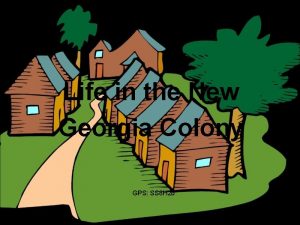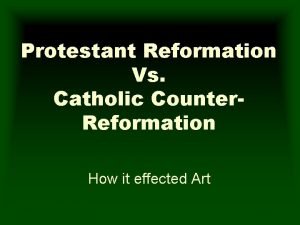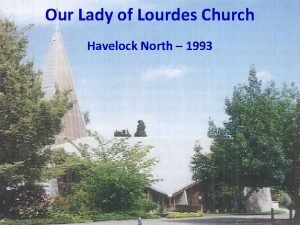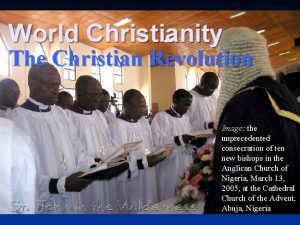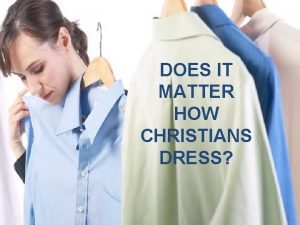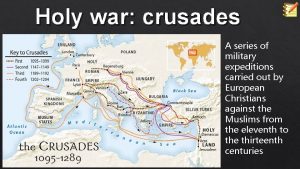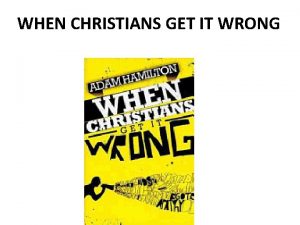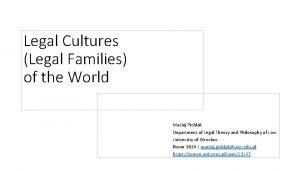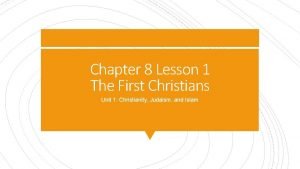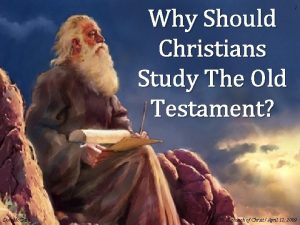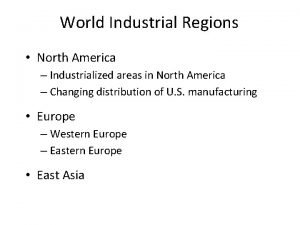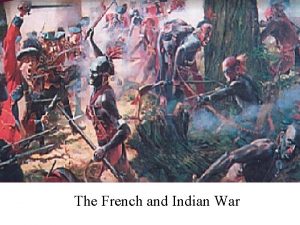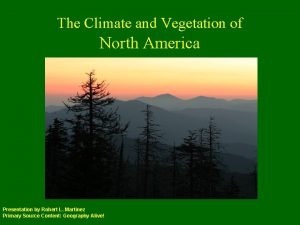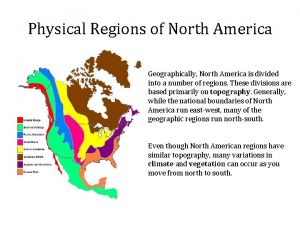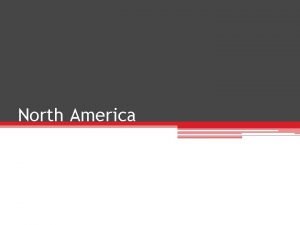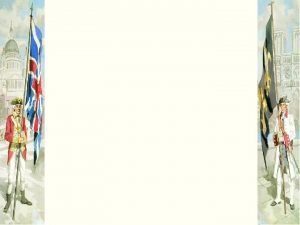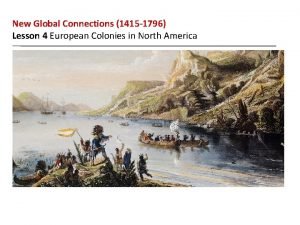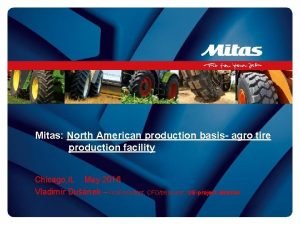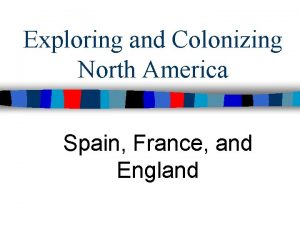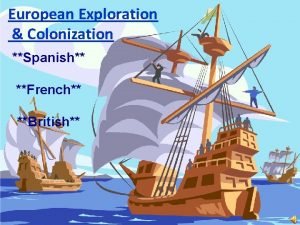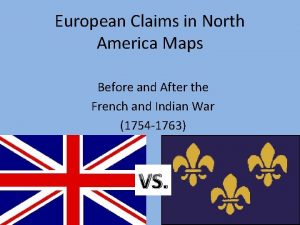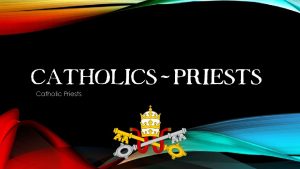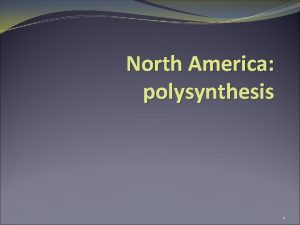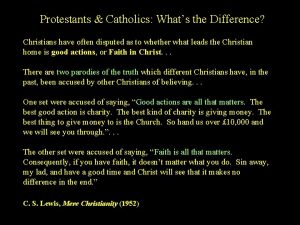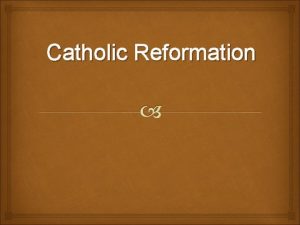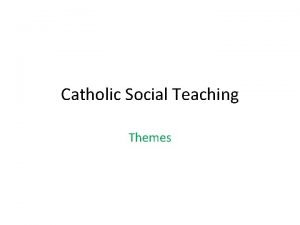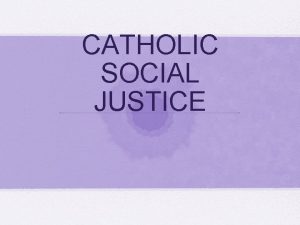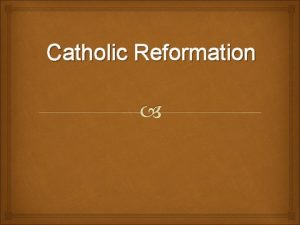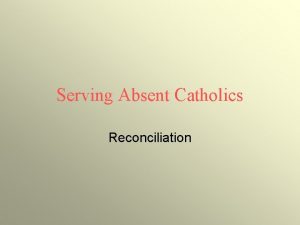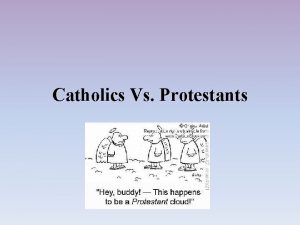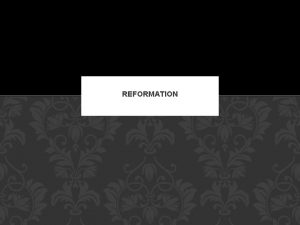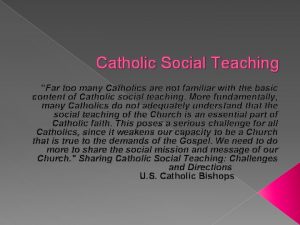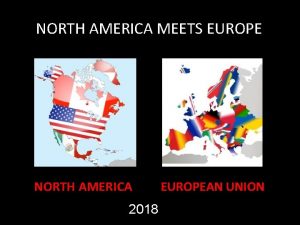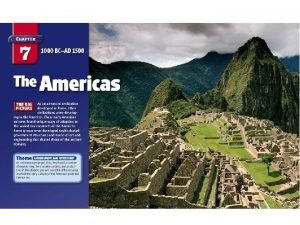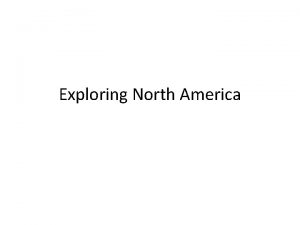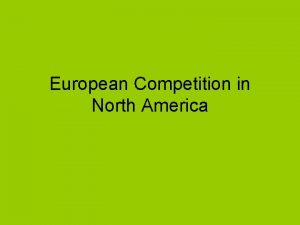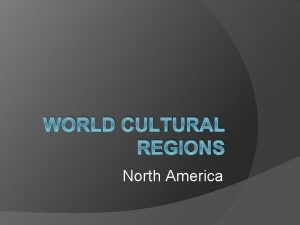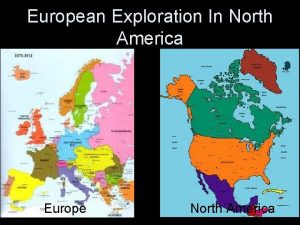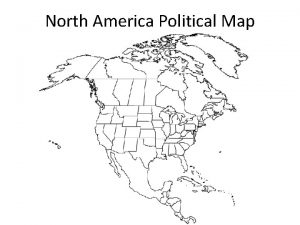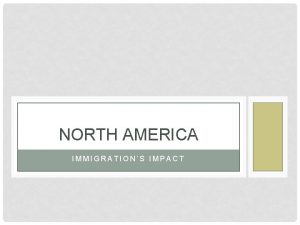Catholic History in North America Catholics are Christians




































- Slides: 36

Catholic History in North America Catholics are Christians Don’t ever make that mistake again!

Things We Have Already Covered • Catholics are Christians: “Christianity” is an umbrella term, NOT a synonym exclusively for evangelical Protestantism • Columbus and contact between Europeans and Native Americans – Temporal proximity of contact (1492) and Reformation (1517) • Virgen de Guadalupe (1532) • California Mission system (1769 -1833) • French v. Spanish manner of Catholic proselytizing

Catholic population in the United States • • • 1790: 35, 000 (mostly MD & PA) 1800: 50, 000 1820: 250, 000 1830: 750, 000 1850: 2, 000 1860: 4, 000 (16 x greater than 1820) 1880: 6, 000 1900: 12, 000 1915: 15, 000 (≈4 x greater than 1860) 1960: 45, 000 (3 x greater than 1915) 2000: 60, 000 2010: 65, 000 (. 5 x greater than 1960) • The United States currently has the fourth largest population of Catholics in the world, behind • 1. Brazil • 2. Mexico • 3. The Philippines • About 25% of U. S. population is Catholic – it is the single largest denomination of Christianity in the U. S.

British Colonies and Catholicism • Catholics were rare in the British colonies • Small Catholic presence in Maryland • French-settled areas, such as Quebec, had more Catholics • British colonists afraid of Catholics, due to wars between England France, and religious trepidations • After French and Indian War, Quebec became part of British empire. This angered the colonists, and found a place among the complaints made to King George III

Catholicism in the Early Republic • French assistance to American revolutionaries led to loosening of anti-Catholic prejudice • Bishop John Carroll, and his brother Charles Carroll of Maryland, were patriots in the revolutionary cause • Bishop John Carroll sets the tone for institutional Catholicism in the new nation

Bishop John Carroll (1735 -1815) Bishop Carrol laying cornerstone of Baltimore Basilica • Inspired by revolutionary ideas • Wanted an educated American Catholic population • Established Georgetown University in Washington DC • Argued for religious tolerance of all sects • Based Catholic hierarchy in Baltimore

Three Great Waves of Immigration • Immigration to the United States has ebbed and flowed, due to – Political considerations • Push and pull – Economic considerations • Push and pull – Escape from tyranny and oppression • Desire for religious freedom – Ease or difficulty in transportation technology

First Wave of Immigration • WHEN: 1820 -1850 • FROM: Northern Europe: Germany, Scandinavia, British Isles: Ireland, Scotland, England • PRINCIPAL RELIGIONS INVOLVED: Roman Catholicism (Ireland, Germany) Judaism (Germany) Mainline Protestants: Presbyterianism (Scotland) Lutheranism (Scandinavia, Germany) Episcopalianism (England) • STARTED WHEN: U. S. survival and success had been assured • ENDED DUE TO: Impending Civil War in U. S.

Second Wave of Immigration • WHEN: 1870 -1924 • FROM: Southern Europe: Italy, Portugal, Greece, Eastern Europe: Poland, Hungary, Slovakia, Ukraine, Russia, West Asia (Middle East): Syria, Lebanon, Palestine, East Asia: China, Japan • PRINCIPAL RELIGIONS INVOLVED: – – – • • Roman Catholicism (Italy, Portugal, Hungary, Poland) Eastern Orthodox Christianity (Greece, Russia, Ukraine, Syria) Judaism (Russia, Poland) Buddhism (Japan, China) Islam (Syria, Palestine, Lebanon) Sikhism (India) STARTED WHEN: Industrial growth and urbanization needed labor ENDED DUE TO: Anti-immigrant sentiment and laws (incl. SCOTUS decision)

Third Wave of Immigration • • • • WHEN: 1964 -? ? FROM: Eastern Europe: former Soviet Union, former Yugoslavia East Asia: Korea, China, Philippines West Asia (Middle East): Iran, Lebanon, Palestine South Asia: Pakistan, India Southeast Asia: Vietnam, Cambodia, Laos, Thailand Latin America: Mexico, El Salvador, Nicaragua, Honduras, Caribbean PRINCIPAL RELIGIONS INVOLVED: Roman Catholicism (Latin America, Philippines, Vietnam) Evangelical Christianity (Korea, Latin America) Buddhism (Southeast Asia, China, Korea) Islam (Pakistan, India, Palestine, Iran) Hinduism (India) Sikhism (India) STARTED WHEN: President Lyndon Johnson changed immigration law NOT YET ENDED!

Immigration and the Catholic Church • The Catholic Church makes substantial gains in each wave of immigration to the United States • Religion plays key roles for immigrants by providing links to homeland, traditions, language, and educated spokespersons in the clergy 'Emigrants Leave Ireland', by Henry Doyle (1827– 1892), published 1868

The First Wave of Immigration 1820 -1850 s German Catholics and Irish Catholics • German Catholics mostly middle-class farmers from southern Germany • Establish monasteries and institutions of higher learning • Concentrated in Midwest • Irish Catholics are very poor due to potato famine • Concentrated in port cities of East coast (NY, Boston, Philadelphia, Baltimore) • Endure extreme prejudice

Irish-American Catholics • Irish potato famine • Oppression of Irish by England • Irish Catholicism as a “badge of ethnicity” – Kept the Irish distinct from English – Provided articulate spokespersons in clergy – Most Irish and Irish. American farm families encouraged at least one son and one daughter to join the Catholic clergy

Irish-American Catholics • Prejudice against the Irish immigrants ran high • Their clergy became politically active, and helped set the stage for the political success of the Irish

Bishop John Hughes (1797 -1864) Bishop Hughes laid out for burial, 1864 Mathew Brady, photographer • Born in Ireland • Comes to U. S. in 1817 • Becomes Bishop of New York in 1838 • Outspoken advocate of Catholicism • Supports Irish immigrants • Opposed to Abolition

Irish-American clergy • The Irish immigrants included substantial numbers of clergy • The numbers of Irish, and their command of English, meant that Irish -American clergy quickly came to dominate the American Catholic Church Los Angeles’ Archbishop Cardinal Roger Mahony

Changes are Happening…in 2011! New bishop, José Horacio Gómez Los Angeles’ Archbishop Cardinal Roger Mahony

The Second Wave of Immigration 1870 to 1924 Southern & Eastern Europe, Philippines • Second Wave of Immigration creates – Vast increase in Catholic population – Vast increase in Catholic ethnic diversity – National Catholic Parishes – Schisms among Catholics over ethnicity – Disputes among Catholics over lay control – Disputes over labor politics – Americanism heresy

Some Catholic Ethnicities in Second Wave • • • Italian-Americans Polish-Americans Portuguese-Americans Hungarian-Americans Slovenian-Americans …among others

Italian-American Immigration • Largely from southern Italy • Catholicism celebrated in cultural festivals and loyalties • Some political distrust of magisterium, and some cultural disregard for magisterium • Poor upon arrival • Staying in East Coast port cities • Earn the ire and contempt of Irish. American clergy

Portuguese-American Immigration • From communities used to fishing and maritime trades, from the Azores as well as Portugal • Widespread national religious festivals help Portuguese immigrants retain their culture in the U. S. – Festival of the Holy Spirit – Festival of the Blessed Sacrament

Polish-American Immigration • Polish immigrants were escaping from the constant warfare that marked their unfortunate homeland • They had a fervent desire to maintain their culture – Polish-Americans saw themselves as virtually a culture-in-exile – Polish language particularly important to maintain – Searching for political alternatives

Assimilation v. Maintaining Culture • The Irish-American clergy urged new immigrants to assimilate – Learn English – Eat American food – Obey the clergy • Irish and Italians clash because of their constant proximity • Many arriving immigrants in the Second Wave had good reason to resist the call to assimilation – Political – Economic – Barriers to assimilation • Polish immigrants so resent the Irish-American call to assimilation, that they move to other regions

The Polish National Catholic Church (PNCC) • Polish immigrants in Scranton, Pennsylvania, form their own Catholic church, separating from the Vatican but maintaining Catholic ritual and theology • Their leader, Francis Hodur (1866 -1953), received “Apostolic Succession” to mark this schism, 1897

The Polish National Catholic Church (PNCC) • Polish immigrants wanted US civil rights to also be spiritual rights • PNC is run democratically – parish advisory board votes on many matters, including doctrinal ones – PNC laywomen could vote on church matters prior to suffrage! – even the Bishop is elected by the people Parish priest at PNCC in Stratford, CT

Oh NO! • The Catholic church DETESTS schism! The Catholic church works like a family, trying to keep all parties together in the discussion, even when there are differences • The Irish-American Catholic clergy and hierarchy were terrified by the PNCC schism, because what if *every* ethnic group did this? – They weren’t about to, because most groups were not as politically motivated or well-organized as the Polish-American immigrants, but the Catholic magisterium did not know that for certain at the time

Catholic National Parishes • The answer: organize churches around ethnic communities – Priests who speak the language – Support for immigrants during life-cycle moments, employment searches, education, etc. • U. S. bishops went to European places from which immigrants were leaving, to recruit young priests • U. S. magisterium had to abrogate a rule from the Council of Trent (1565!) concerning geography and parish membership

Catholic National Parishes • Became centers of cultural distinctiveness, giving way to very gradual assimilation • Story of Holy Cross Slovenian Catholic Church in Fairfield, CT

Holy Cross Slovenian Catholic Church • Story of Holy Cross Slovenian Catholic Church in Fairfield, CT • They have a Facebook page: Holy Cross FB page

Five Wounds Portuguese Catholic Church, San José • Established by the community 1914 • Used wood from Portugal exhibit at San Francisco world’s fair • Celebrates Portuguese mariners in anteroom! • Still operating as a Catholic National Parish because of the ongoing arrival of Portuguesespeaking immigrants…though this is an endangered status

Five Wounds Portuguese Catholic Church, San José Five Wounds is based on Braga Cathedral

Important American Catholics for Further Discussion • Dorothy Day – Left-wing Catholic social worker, newspaper editor, and pacifist • Father Coughlin – Right-wing Catholic radio personality in the 1930 s • Thomas Merton – American Catholic monk and mystic • Fulton Sheen – American Catholic bishop, intellectual, and media star in the 1950 s • Vatican II – general conference of the Catholic church, held in the early 1960 s, that brings reform and ecumenism to the fore

Important American Catholics and Issues for Further Discussion • John F. Kennedy – Irish-American politician; first (and, to now, only) Catholic President of the United States • The Berrigan brothers • Cesar Chavez • Right v. Left split politically – Abortion – Birth Control – Foreign Policy and Militarism • Third Wave of Immigration – Asian Catholics (Vietnamese, Filipino) – Increase in Latino Catholics

Current Supreme Court (2011) • • How many can you name? How many are Catholic?

Current Supreme Court (2011) • Seated, Clarence Thomas, Antonin Scalia, Chief Justice John Roberts, Samuel Alito, Ruth Bader Ginsburg • Standing, Sonia Sotomayor, Anthony Kennedy, Stephen Breyer, Elena Kagan

Current Supreme Court (2011) • Seated: Clarence Thomas (RCC), Antonin Scalia (RCC), Chief Justice John Roberts (RCC), Samuel Alito (RCC), Ruth Bader Ginsburg (Judaism) • Standing: Sonia Sotomayor (RCC), Anthony Kennedy (RCC), Stephen Breyer (Judaism), Elena Kagan (Judaism) – first time ever no Protestant!
 Mikael ferm
Mikael ferm Catholic vs protestant
Catholic vs protestant Asia africa song
Asia africa song Protestant reformation vs counter reformation
Protestant reformation vs counter reformation Catholic church havelock north
Catholic church havelock north Number of christians in the world
Number of christians in the world Kuttonet
Kuttonet Save teachers sundays
Save teachers sundays Military expeditions carried out by european christians
Military expeditions carried out by european christians Why christians should not celebrate halloween
Why christians should not celebrate halloween When christians get it wrong
When christians get it wrong India christians laws
India christians laws Lesson 1 the first christian answer key
Lesson 1 the first christian answer key The disciples were first called christians
The disciples were first called christians Christians ö
Christians ö When christians get it wrong
When christians get it wrong Colosse 12
Colosse 12 What is postmodern philosophy
What is postmodern philosophy Why did romans treat christians so badly?
Why did romans treat christians so badly? Rap of the states
Rap of the states Whats an onomatopeia
Whats an onomatopeia Why is called latin america
Why is called latin america Happening body art
Happening body art World's industrial regions map
World's industrial regions map Air masses in north america
Air masses in north america North america 1754
North america 1754 North america vegetation zones
North america vegetation zones 8 physical regions of north america
8 physical regions of north america Ottawa in north america map
Ottawa in north america map Spain and portugal
Spain and portugal North canada provinces
North canada provinces North america map 1750
North america map 1750 European colonies in north america
European colonies in north america Mitas tires north america
Mitas tires north america European colonization of americas
European colonization of americas European colonies in north america
European colonies in north america European claims in north america map
European claims in north america map

